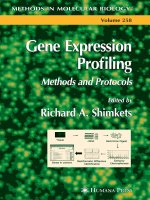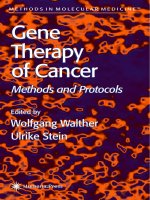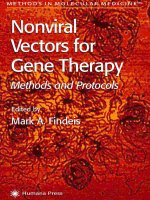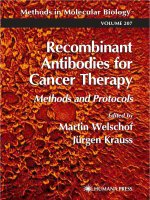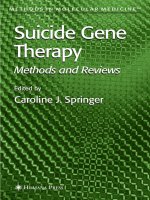nonviral vectors for gene therapy, methods and protocols
Bạn đang xem bản rút gọn của tài liệu. Xem và tải ngay bản đầy đủ của tài liệu tại đây (2.99 MB, 381 trang )
M E T H O D S I N M O L E C U L A R M E D I C I N E
TM
Edited by
Mark A. Findeis
Nonviral
Vectors for
Gene Therapy
Methods and Protocols
Humana Press
Humana Press
Edited by
Mark A. Findeis
Nonviral
Vectors for
Gene Therapy
Methods and Protocols
Synthesis of Polyampholyte Comb-Type Copolymer 1
1
From:
Methods in Molecular Medicine, vol. 65: Nonviral Vectors for Gene Therapy
Edited by: M. A. Findeis © Humana Press Inc., Totowa, NJ
1
Synthesis of Polyampholyte Comb-Type Copolymers
Consisting of Poly(
L-lysine) Backbone and Hyaluronic
Acid Side Chains for DNA Carrier
Atsushi Maruyama and Yoshiyuki Takei
1. Introduction
Polycations have been used as nonviral gene carriers because the polycations
and DNAs form stable complexes in a noncovalent manner (1–3). The
polycations, e.g., poly(
L-lysine) (PLL), are reported to be conjugated with
several ligands for targeted gene delivery (4–8). The physicochemical
properties of the DNA complexes have been described as factors that influence
transfection activity (9–11).
The authors have reported (12,13) several comb-type copolymers consisting
of a PLL backbone and hydrophilic dextran side chains for controling the
assembling structure of DNA–copolymer complexes. The dextran chains grafted
onto PLL are found to reduce aggregation of the resulting complexes and to
increase the solubility of the complexes. Furthermore, the grafting degree of the
copolymer affects the DNA conformation in the complex, allowing regulation of
DNA compaction. The comb-type copolymers with a higher degree of grafting
induce little compaction of DNA and stabilize DNA duplexes and triplexes by
shielding the repulsion between phosphate anions of DNA. Moreover, the grafted
chains reduce the nonspecific interaction of the PLL backbone with proteins (14).
The comb-type copolymers therefore fulfill several requirements for the cell-
specific carrier of DNA, if the copolymers are provided with cell-specific ligands.
Hyaluronic acid (HA) is an unbranched high-molecular-weight polysaccharide
consisting of alternating N-acetyl-`-
D-glucosamine and `-D-glucuronic acid resi-
dues linked at the 1.3 and 1.4 positions, respectively (15). Liver sinusoidal
endothelial cells possess the receptors that recognize and internalize HA (16,17).
More than 90% of HAs in the blood stream are known to be taken up and metabo-
2 Maruyama and Takei
lized by SECs. The authors are therefore interested in HA as the ligand to deliver
the DNA to the SEC. The authors’ recent study (18) shows that the complexes
between PLL–HA conjugates and reporter genes were distributed exclusively in
SECs, leading to gene expression in vivo.
This chapter describes preparation of PLL-graft-HA (PLL-g-HA) comb-type
copolymers. For the synthesis of the comb-type copolymers, high-molecular-
weight HA was hydrolyzed, then the HAs were covalently coupled with ¡-amino
groups of PLL at their reducing end by reductive amination reaction.
2. Materials
2.1. Enzymatic Hydrolysis of HA
1. High-molecular-weight HA (5.9 × 10
2
kDa), obtained as its sodium salt (sodium
hyaluronate), was a gift from Denki Kagaku Kogyo (Tokyo, Japan).
2. Bovine testicular hyaluronidase (EC 3.2.1.35; Type I-S, Sigma, St. Louis, MO).
3. Syringe filters, 0.45 µm (New Steradisc 25, Kurabo, Osaka, Japan).
2.2. Synthesis of PLL-
g
-HA Comb-Type Copolymers
1. PLL, obtained as its chloride or bromide salt, was purchased from Peptide
Institute (Osaka, Japan).
2. Sodium borate buffer-NaCl: 0.1 M, pH 8.5, 0.4–1 M NaCl.
3. Sodium cyanoborohydride (NaBH
3
CN).
4. NaCl solution (0.5 M).
5. Dialysis membrane (Spectra/Por 7, mol wt cut-off 25,000).
6. Distilled water.
2.3. Size Exclusion Chromatography (SEC)–Multiangle Laser Light
Scattering (MALLS) Apparatus
1. Chromatography pumping system operating at 1.0 mL/min.
2. Size exclusion chromatography column(s).
3. NaNO
3
(0.1 M) containing 5 mM sodium phosphate buffer, pH 8.0.
4. Na
2
SO
4
(0.2 M) containing 5 mM sodium phosphate buffer, pH 8.0.
3. Methods
3.1. Enzymatic Hydrolysis of HA
1. Dissolve hyaluronic acid (1 g) in 120 mL water.
2. Add 20 mg bovine testicular hyaluronidase and stir at 50°C.
3. Use a small portion of the reaction to trace HA molecular weight change by
SEC–MALLS.
4. When the desired molecular weight of the HA is reached, boil the mixture for 5 min
to terminate the reaction.
5. After cooling down to room temperature, filter the mixture through a 0.45-µm
filter to remove the denatured enzyme. The resulting HA fragments were obtained
by freeze-drying.
Synthesis of Polyampholyte Comb-Type Copolymer 3
Figure 1 shows the time course of the HA hydrolysis determined by a SEC–
MALLS apparatus (see Subheadings 2.3. and 3.3.). The rate of hydrolysis depends
on enzyme activity, so that preliminary experiment on a small scale is
recommended to estimate hydrolysis rate before a large-scale reaction. The rate of
hydrolysis can be regulated by changing enzyme concentration. For graft copoly-
mer synthesis, a molecular weight ranging from 3000 to 10,000 is favorable.
Because the hydrolyzed product has a large distribution in molecular weight, it is
also recommended to fractionate fragments by dialysis or ultrafiltration.
3.2. Synthesis of PLL-
g
-HA Comb-Type Copolymers
The obtained HA fragments were conjugated to PLL by reductive amination
using NaBH
3
CN as a reducing agent (Scheme 1). The reaction proceeded
through two steps. First is the Schiff’s base (-CH=N-) formation between a
reductive (aldehyde) end of HA and primary amino groups of PLL. Second is
reduction of the Schiff’s base to form secondary amino groups (-CH
2
-NH).
Although the Schiff’s base is unstable and reversible, its reduced product is an
irreversible covalent product.
1. Dissolve the PLL (60–120 mg) in 15 mL sodium borate buffer (0.1 M, pH 8.5)
containing 0.4–1 M NaCl.
2. Add the HA fragment (100–300 mg) to the solution. If turbidity or precipitation
was observed, increase NaCl concentration. PLL and HA may form an
interpolyelectrolyte complex, which is unfavorable for graft copolymer synthesis.
The complex formation can be avoided by increasing NaCl concentration.
3. Stir the mixture at 40°C for a few hours for Schiff’s base formation.
Fig. 1. Time-course of the hydrolysis of HA by hyaluronidase detected by SEC–
MALLS. HA (5.9 × 10
2
kDa; 1 g) was hydrolyzed by hyaluronidase (20 mg) at 50°C.
(mL)
4 Maruyama and Takei
4. Add NaBH
3
CN to the mixture and allow to stand at 40°C for 2 d. Approximately
10 molar excess of NaBH
3
CN to HA is recommended.
5. Sample the solution and trace the reaction with SEC–MALLS (see Subheading
3.3. for SEC–MALLS procedure).
6. Purify the mixture by dialysis against 0.5 M NaCl aqueous solution using a Spec-
tra/Por 7 membrane (mol wt cut-off = 25,000).
7. Desalt the sample by dialysis against distilled water, the resulting copolymer is
obtained by freeze-drying. The resulting copolymer would be precipitated during
the dialysis.
Figure 2 shows the time-course of the coupling reaction between PLL and
HA traced by SEC–MALLS. The reaction can be detected as a decrease in peak
area of free HA, increase in peak of the copolymer and in molecular weight of
the copolymer. The coupling was almost completed within a few days of incuba-
tion. Note that the free HA is almost eliminated after the reaction.
Scheme 1. Synthesis of PLL-g-HA comb-type copolymers. Reprinted with permission
from ref. 19. Copyright 1998, American Chemical Society.
Synthesis of Polyampholyte Comb-Type Copolymer 5
3.3. SEC–MALLS
SEC was carried out using a JASCO 880-PU pumping system (Tokyo, Japan) at
the flow rate of 1.0 mL/min at 25°C, with Ultrahydrogel series (Japan Waters,
Tokyo, Japan) or Shodex OH pack SB-series (Showa Denko, Tokyo, Japan). A
suitable combination of mobile phase and columns must be chosen, because poly-
electrolytes including HA and PLL are liable to interact with the column packings,
leading to delay in elution volume. In such case, molecular weight determination
using the calibration curve based on molecular weight standard samples such as
polyethyleneglycol and pullulan is not reliable. The choice of the mobile-phase
rely on gel permeation chromatography (GPC) columns. It is highly recommended
to provide a light-scattering (LS) detector system such as MALLS (Multiangle
laser light scattering detector, Dawn-DSP, Wyatt Technology, Santa Barbara, CA).
By using a LS detector, a direct estimation of the molecular weight is possible.
The mobile phases we used are 0.1 M NaNO
3
for HA fragment analysis and
0.2 M Na
2
SO
4
containing 5 mM sodium phosphate buffer (pH 8.0) for copoly-
mer analysis. For typical analysis, 200 µL of each sample was picked up from
the reaction mixture and injected into the columns. Eluate was detected by a
refractive index (RI) detector (830-RI, JASCO) and a MALLS detector. RI and
LS signals were transferred to a computer to calculate number-average and
weight-average molecular weight according to the instruction manual (Wyatt
Technology) for Dawn-DSP.
3.4.
1
H Nuclear Magnetic Research (NMR) Spectroscopic Analyses
Each copolymer was dissolved in D
2
O (Deuterium content: 99.95% Merck,
Darmstadt, Germany) containing 0.35 M NaCl.
1
H-NMR spectra (400 MHz) were
Fig. 2. Time-course of coupling reaction between PLL and HA detected by SEC–
MALLS.
6 Maruyama and Takei
obtained by a Varian Unity 400plus spectrometer (Palo Alto, CA), at a probe
temperature of 298 K. The chemical shifts are expressed as parts/million using
internal HDO molecules (b = 4.7 ppm in D
2
O) as a reference.
As shown in Fig. 3, the
1
H-NMR spectra of the comb-type copolymer showed
the characteristic signals of both PLL and HA moieties: PLL, b 1.4–1.8 (`, a,
b-CH
2
), 3.0 (¡-CH
2
), 4.3 (_-CH); HA, b 2.0 (NAc-CH
3
), 3.3–3.9 (H-2,3,4,5,6),
4.4–4.6 (H-1). From the signal ratio of methyl protons (2.0 ppm) of the N-acetyl
groups of the HA-grafts to ¡-methylene protons (3.0 ppm) of the PLL backbone,
the content (wt % and grafting-%) of HA in the copolymer was determined. The
results of the synthesis of PLL-g-HA comb-type copolymers are summarized in
Table 1. Coupling efficiency was more than about 70%. Consequently, the authors
have easily prepared the various PLL–HA conjugates with a well-defined comb-
type structure by combining enzymatic hydrolysis and the reductive amination.
Fig. 3.
1
H NMR spectra of PLL (A), HA (B), and PLL-g-HA (C) in D
2
O. For the
PLL-g-HA, D
2
O containing 0.35 M NaCl was used. Reprinted with permission from
ref. 19. Copyright 1998, American Chemical Society.
Synthesis of Polyampholyte Comb-Type Copolymer 7
7
Table 1
Synthesis of PLL-g-HA Comb-Type Copolymers
a
In feed Copolymer Coupling
PLL HA Mol wt
b
HA Content
c
efficiency
d
Yield
Charge
Sample
M
n
b
/10
4
mg M
n
b
/10
3
mg wt% M
n
/10
4
M
w
/M
n
wt%
Grafting-%
ratio % %
1 4.2 61.2 2.3 94.3 61 8.5 1.5 50 5.7 0.34 66 67
2 4.2 61.2 2.3 189 76 11 1.4 63 9.4 0.56 55 57
3 7.2 122 3.8 189 61 15 1.4 53 3.8 0.40 73 55
4 7.2 61.2 3.8 189 76 23 1.6 69 7.6 0.83 73 83
5 7.2 61.2 3.8 283 82 31 1.5 77 11 1.3 71 57
6 4.2 61.2 1.6 94.3 61 9.3 1.4 55 9.8 0.49 80 38
7 7.2 122 1.6 94.3 44 12 1.5 38 4.9 0.22 80 51
8 7.2 61.2 1.6 189 76 24 1.4 71 19 1.0 77 85
a
Reducing reagent, 0.3 M NaBH
3
CN; reaction temperature, 40°C; reaction time, 56 h (samples 1 and 2), 80 h (samples 3–5), 75 h (samples 6–8);
solvent, 0.1 M sodium borate buffer (pH 8.5) containing 0.4 M NaCl (samples 1 and 2) or 1 M NaCl (samples 3–8).
b
Molecular weight and its distribution (M
w
/M
n
) were determined by SEC–MALLS.
c
Determined by
1
H-NMR; grafting-% = (mol fraction of the lysine residues grafted with HA) × 100%; charge ratio = [carboxyl group]
HA
/
[amino group]
PLL
in copolymer.
d
[HA]
copolymer
/[HA]
in feed
× 100%. Reprinted from ref. 19. Copyright 1998, American Chemical Society.
8 Maruyama and Takei
References
1. Kabanov, A. V., Astafyeva, I. V., Chikindas, M. L., Rosenblat, G. F., Kiselev, V. I.,
Severin, E. S., and Kabanov, V. A. (1991) DNA interpolyelectrolyte complexes
as a tool for efficient cell transformation. Biopolymers 31, 1437–1443.
2. Boussif, O., Lezoualc’h, F., Zanta, M. A., Mergny, M. D., Scherman, D.,
Demeneix, B., and Behr, J. P. (1995) A versatile vector for gene and oligonucle-
otide transfer into cells in culture and in vivo: Polyethylenimine. Proc. Natl. Acad.
Sci. USA 92, 7297–7301.
3. Page, R. L., Butler, S. P., Subramanian, A., Gwazdauskas, F. C., Johnson, J. L.,
and Velander, W. H. (1995) Transgenesis in mice by cytoplasmic injection of
polylysine/DNA mixtures. Transgenic Res. 4, 353–360.
4. Wu, G. Y. and Wu, C. H. (1987) Receptor-mediated in vitro gene transformation
by a soluble DNA carrier system. J. Biol. Chem. 262, 4429–4432.
5. Wagner, E., Cotten, M., Foisner, R., and Birnstiel, M. L. (1991) Transferrin-
polycation-DNA complexes: the effect of polycations on the structure of the
complex and DNA delivery to cells. Proc. Natl. Acad. Sci. USA 88, 4255–4259.
6. Huckett, B., Ariatti, M., and Hawtrey, A. O. (1990) Evidence for targeted gene
transfer by receptor-mediated endocytosis: stable expression following insulin-
directed entry of neo into HepG2 cells. Biochem. Pharmacol. 40, 253–263.
7. Trubetskoy, V. S., Torchilin, V. P., Kennel, S. J., and Huang, L. (1992) Use of
N-terminal modified poly(L-lysine)-antibody conjugate as a carrier for targeted
gene delivery in mouse lung endothelial cells. Bioconjugate Chem. 3, 323–327.
8. Martinez-Fong, D, Mullersman, J. E., Purchio, A. F., Armendariz-Borunda, J.,
and Martinez-Hernandez, A. (1994) Nonenzymatic glycosylation of poly-
L-lysine:
a new tool for targeted gene delivery. Hepatology 20, 1602–1608.
9. Perales, J. C., Grossmann, G. A., Molas, M., Liu, G., Ferkol, T., Harpst, J., Oda,
H., and Hanson, R. W. (1997) Biochemical and functional characterization of
DNA complexes capable of targeting genes to hepatocytes via the
asialoglycoprotein receptor. J. Biol. Chem. 272, 7398–7407.
10. Wolfert, M. A., Schacht, E. H., Toncheva, V., Ulbrich, K., Nazarova, O., and
Seymour, L. W. (1996) Characterization of vectors for gene therapy formed by
self-assembly of DNA with synthetic block co-polymers. Hum. Gene Ther. 7,
2123–2133.
11. Kabanov, A. V. and Kabanov, V. A. (1995) DNA complexes with polycations for
the delivery of genetic material into cells. Bioconjugate Chem. 6, 7–20.
12. Maruyama, A., Katoh, M., Ishihara, T., and Akaike, T. (1997) Comb-type
polycations effectively stabilize DNA triplex. Bioconjugate Chem. 8, 3–6.
13. Maruyama, A., Watanabe, H., Ferdous, A., Katoh, M., Ishihara, T., and Akaike, T.
(1998) Characterization of interpolyelectrolyte complexes between double-
stranded DNA and polylysine comb-type copolymers having hydrophilic side
chains. Bioconjugate Chem. 9, 292–299.
14. Maruyama, A., Ishihara, T., Kim, J. S., Kim, S. W., and Akaike, T. (1997)
Nanoparticle DNA carrier with poly(L-lysine) grafted polysaccharide copolymer
and poly(D,L-lactic acid). Bioconjugate Chem. 8, 735–742.
Synthesis of Polyampholyte Comb-Type Copolymer 9
15. Balazs, E. A., Laurent, T. C., and Jeanloz, R. W. (1986) Nomenclature of hyalu-
ronic acid. Biochem. J. 235, 903.
16. Forsberg, N. and Gustafson, S. (1991) Characterization and purification of the
hyaluronan-receptor on liver endothelial cells. Biochim. Biophys. Acta 1078, 12–18.
17. Yannariello-Brown, J., Frost, S. J., and Weigel, P. H. (1992) Identification of the
Ca
2+
-independent endocytic hyaluronan receptor in rat liver sinusoidal endothelial
cells using a photoaffinity cross-linking reagent. J. Biol. Chem. 267, 20,451–20,456.
18. Takei, Y., Maruyama, A., Nogawa, M., Asayama, S., Ikejima, K., Hirose, M., et al.
(1999) A novel gene delivery system for genetic manipulation of sinusoidal
)endothelial cells by triplex DNA technology: evaluation of targetability and abil-
ity to stabilize triplex formation. Hepatology 30, 298A.
19. Asayama, S., Nogawa, M., Takei, Y., Akaika, T., Maruyama, A. (1998) Synthesis of
novel polyampholyle comb-type copolymers consisting of poly (L-lysine) backbone
and hyaluronic acid side chains for a DNA carrier. Bioconjugate Chem. 9, 476–481.
Cationic
_
-Helical Peptides 11
11
From:
Methods in Molecular Medicine, vol. 65: Nonviral Vectors for Gene Therapy
Edited by: M. A. Findeis © Humana Press Inc., Totowa, NJ
2
Cationic _-Helical Peptides for Gene Delivery
into Cells
Takuro Niidome and Haruhiko Aoyagi
1. Introduction
Development of nonviral gene transfer techniques has progressed, particu-
larly the use of several kinds of cationic lipids and cationic polymers such as
polylysine derivatives, polyethyleneimines, polyamidoamine dendrimers, and
so on, which electrostatically form a complex with the negatively charged
DNA, which can be taken up by the cells. Furthermore, targeted gene transfer
has also been realized by modification of the gene carriers using cell-targeting
ligands such as asialoorosomucoid, transferrin, insulin, or galactose.
Recently, novel gene transfer techniques have been reported, in which an
amphiphilic _-helical peptide, containing cationic amino acids is used as a
gene carrier into cells. Wyman et al. (1) employed a peptide, KALA (WEAK-
LAKA-LAKA-LAKH-LAKA-LAKA-LKAC-EA), which is derived from the
sequence of the N-terminal segment of the HA-2 subunit of the influenza virus
hemagglutinin involved in the fusion of the viral envelope with the endosomal
membrane. This peptide showed several functions in the transfection process,
e.g., condensing DNA and causing an endosome-membrane perturbation,
which enables it to deliver the incorporated DNA to the cytosol, which is
essential for efficient transfection. Similarly, the authors also found the
transfection technique, which is mediated by some amphiphilic _-helical
peptides (e.g. Ac-LARL-LARL-LARL-LRAL-LRAL-LRAL-NHCH
3
[4
6
] and
KLLK-LLLK-LWKK-LLKL-LK [Hel]) as shown in Table 1 (2–5). After that,
for the purpose of refining of the peptide structure, we investigated the
influence of the peptide chain length on gene transfer ability. As a result, 16
and 17 amino acid residues were sufficient to form aggregates with the DNA,
12 Niidome and Aoyagi
and transfer the DNA into the cells in the deletion series of 4
6
and Hel, respectively
(Table 1; 6). In addition, the authors succeeded in constructing a multiantennary
galactose-modified peptide containing four galactose residues that serve for
efficient binding to the asialoglycoprotein receptor on hepatoma cells (7).
This chapter focuses on synthesis of the peptides and a method of gene trans-
fer using them. As is well known, a peptide is readily synthesized because of
the development of an automatic peptide synthesis apparatus and reagents for
synthesis. From this point of view, it is expected that the gene transfer method
mediated by the peptide is easily accepted by many researchers taking part in
the gene therapy study.
2. Materials
2.1. Peptide Synthesis
1. Peptide synthesis apparatus (ABI 431A, PE Biosystems).
2. Fmoc-Lys(Boc) preloaded Wang resin, Rink amide resin (100–200 mesh)
(Calbiochem-Novabiochem, CA).
3. Fmoc protected amino acids, 2-(1H-benzotriazole-1-yl)-1,1,3,3,-tetrame-
thyluronium hexafluorophosphate (HBTU), N,N,-diisopropylethylamine,
NMP, dichloromethane (DCM), piperidine (Watanabe Chemical, Hiroshima, Japan).
4. Thioanisole, m-Cresol, ethandithiol, trifluoracetic acid (TFA), acetonitrile (Wako
Chemicals, Osaka, Japan).
5. High-performance liquid chromatography (HPLC) apparatus (Hitachi L7100
System, Tokyo, Japan).
6. Reverse-phase (RP)-HPLC column (YMC-Pack C4, q10 × 150 mm, Kyoto, Japan).
7. Matrix-assisted Laser Desorption Ionization-Time of Flight-Mass Spectra
(MALDI TOF-MS) apparatus (Voyager DE STR, PE Biosystems).
2.2. Preparation of Plasmid DNA
1. Plasmid DNA, which contains a luciferase gene and SV40 promoter (PicaGene
control vector, PGV-C), was purchased from Toyo Ink (Tokyo, Japan).
2. Plasmid DNA (pCMVluc), containing a luciferase gene under control of
cytomegalovirus enhancer/promoter, was prepared by removing the BglII and
Table 1
Structures of Amphiphilic _-Helical Peptides
Chain Cationic
Peptide Sequence length charge
4
6
Ac-LARL-LARL-LARL-LRAL-LRAL-LRAL-NH
2
24 6
4
6
68 Ac-LARL-LRAL-LRAL-LRAL-NH
2
16 4
Hel KLLK-LLLK-LWKK-LLKL-LK 18 7
Hel61 LLK-LLLK-LWKK-LLKL-LK 17 6
Cationic
_
-Helical Peptides 13
HindIII insert of the plasmid PGV-C (Toyo Ink), and ligating with the BglII
and HindIII fragment from the pRc/CMV (Invitrogen), which contains
cytomegalovirus promoter.
3. Closed circular plasmid DNA was purified by ultracentrifugation in cesium chlo-
ride gradients. The plasmid preparations showed a major band of closed circular
DNA and minor amount (<20%) of nicked plasmid.
2.3. Cell Culture and Gene Transfer into Cells
1. COS-7 cells (a monkey kidney cell line, RCB accession no. RCB0539), HeLa cells
(a human cervix, RCB accession no. RCB0271) and CHO cells (a Chinese hamster
ovary, RCB accession no. RCB0285) (RIKEN Cell Bank, Tsukuba, Japan).
2. HuH-7 cells (a human hepatoma cell line, JCRB accession no. JCRB0403)
(Health Science Research Resources Bank, Osaka, Japan).
3. Dulbecco’s modified Eagle’s medium, RPMI 1640, media supplements, and heat-
inactivated fetal calf serum (IWAKI Glass, Chiba, Japan).
4. PicaGene luminescence kit (Toyo Ink).
5. Luminometer (Maltibiolumat LB9505, Berthold, Germany).
3. Methods
3.1. Peptide Synthesis
As shown in Table 1, the authors recommend two kinds of peptides, 4
6
68
and Hel61, which were refined from two original _-helical peptides, 4
6
and
Hel, respectively (6).
3.1.1. Elongation of Peptide Chain on Resin
Peptides can be manually synthesized by the stepwise elongation of Fmoc
protected amino acid on Rink amide resin (for 4
6
; 4-(2',4'-dimethoxyphenyl-
Fmoc-aminomethyl)-phenoxy resin, 0.43 mmol/g resin) or Fmoc-Lys(Boc)
preloaded Wang resin (for Hel; Fmoc-Lys(Boc)-p-benzoyloxy alcohol resin,
0.58 mmol/g resin) in 0.1 mmol scale as described by Fields et al. (8), and in
Catalog & Peptide Synthesis Handbook of Calbiochem-Novabiochem. The
Fmoc amino acid derivatives used are as follows: Ala, Arg(Pbf), Leu,
Lys(Boc), and Trp. The coupling protocol is shown as follows:
1. Wash: 2 mL DCM (3×).
2. Wash: 2 mL NMP (3×).
3. Wash: 2 mL of 20% piperidine/N,N,-dimethylformamide (1×).
4. Deprotection of Fmoc group: 2 mL 20% piperidine/DMF (15 min).
5. Wash: 2 mL NMP (5×).
6. Coupling of amino acid; Fmoc-amino acid (0.3 mmol), HBTU (0.3 mmol), HOBt
(0.3 mmol), and N,N,-diisopropylethylamine (DIEA) (0.6 mmol) in 3 mL
NMP:DMF (1:1) (15 min).
7. Wash: 2 mL DMF (3×).
8. Kaiser test (9): When the coupling is incomplete, the protocol is repeated from step 6.
14 Niidome and Aoyagi
As a matter of course, it is possible to elongate the peptide chain using automatic
peptide synthesizer (PE Biosystems, ABI 431A). In this case, the peptides are also
synthesized by FastMoc method in 0.1 mmol scale. Even if single coupling of amino
are applied for all elongation steps, satisfactory peptides in purity are obtained. In the
case of modifying by acetyl group to N-terminal of peptide, 4
6
, the Fmoc-deprotected
peptide on resin is treated with 1 mmol acetic anhydride in 2 mL NMP for 20 min.
After the resin is washed by DCM and methanol, they are dried in vacuo.
3.1.2. Deprotection and Cleavage of Peptide Resin
The protecting groups and the resin are removed with TFA (2.0 mL) in the
presence of m-cresol (60 µL), ethandithiol (180 µL), and thioanisole (360 µL),
in a round flask. After swirling at room temperature for 60 min, the resin is
removed by filtration under reduced pressure and washed by TFA. Twenty
milliliters of cold diethylether is added to the filtrate, then, the flask can be
cooled with ice to further assist precipitation. Crude peptide is isolated by fil-
tration under reduced pressure and washed by cold diethylether.
The crude peptides can be purified by RP-HPLC on a YMC-Pack C4 column
(q10 × 250 mm) with a linear gradient of water–acetonitrile containing 0.1% TFA.
Peptide 4
6
68 and Hel61 are eluted at about 80 and 55% of acetonitrile, respec-
tively. The authors recommend that if possible, the crude peptide be passed through
a column of Sephadex G-10 or G-15 (q10 × 250 mm) with 10% acetic acid before
purification by RP-HPLC to avoid damaging the HPLC column. The peptide frac-
tions are collected, then lyophilized. The yields obtained after purification are about
80 (34 µmol) and 100 mg (36 µmol) in the cases of 4
6
68 (as 4TFA salt) and Hel61
(as 6TFA salt), respectively. The purified peptides can easily be identified by
MALDI-TOF-MS ([M + H]
+
= 1874.4 [4
6
68], 2105.7 [Hel61]).
3.2. Preparation of Peptide–DNA Complex
Complex of peptide and DNA is prepared by mixing 2.5 µg plasmid DNA
(PGV-C) with the peptides at peptide:DNA charge ratio of 2.0 in serum-free
medium. The authors protocol is shown as follows:
1. Prepare the DNA solution: 2.5 µg plasmid DNA in 250 µL serum-free culture
medium.
2. Prepare the peptide solution: 1.6 mM (as cationic groups) peptide aqueous solu-
tion. Practically, 930 µg 4
6
68 • 4TFA or 743 µg Hel61 • 6TFA are dissolved in
1.0 mL sterilized water.
3. 10 µL Peptide solution is added to 250 µL plasmid DNA solution.
4. Stand for 15 min at room temperature.
3.3. Gene Transfer Protocol into Cultured Cells
1. Plate cells in 24-well tissue culture dishes (q16 mm) at 1 × 10
5
cells/well and
grow overnight in an atmosphere of 5% CO
2
at 37°C.
Cationic
_
-Helical Peptides 15
2. Wash twice with 1 mL serum free medium.
3. The peptide–DNA complex as described above is poured gently to the cells.
4. After incubation for 3 h at 37°C, 1 mL medium containing serum is added.
5. After incubation for 12 h at 37°C, the medium is replaced with 1 mL fresh
medium containing serum and the cells are further incubated for 24 h.
6. Harvest of cells and luciferase assays are performed as described in the protocol
of PicaGene luminescence kit using a luminometer.
7. The protein concentrations of the cell lysates are measured by Bradford assay
using bovine serum albumin as a standard. The light unit values shown in the
figures represent the specific luciferase activity (relative light units/mg protein),
which is standardized for total protein content of the cell lysate. The measure-
ment of gene transfer efficiency is performed in triplicate.
To date, the authors have tested gene transfer efficiencies of the peptides into
several cell lines, such as COS-7, HeLa, CHO, and HuH-7 cells. Figure 1 shows
the results for each cell line. To compare the efficiencies of the peptides to a
commercially available gene transfer agent, we employed Lipofectin (Gibco-BRL).
As a result, the efficiencies of the peptides were similar to or about 10-fold lower
than those of Lipofectin. Except for the case of needing a large amount of expres-
sion product, it can be said that the peptides are enough to use as a gene carrier. On
the other hand, the peptides showed different efficiencies depending on the cell
lines. These peptides can be chosen according to the cell lines.
The authors also evaluated cytotoxic activities of the peptide–DNA
complexes, using Alamer Blue
TM
, under the same conditions as those in the
transfection procedure. As a result, little cytotoxic activity of the complexes
could be observed. However, when the complex is prepared at peptide:DNA
charge ratio of 4 and more, considerable cytotoxic activities are observed,
which the authors consider to result from membrane perturbation activities
originated from the amphiphilic structures of the peptides (3,5).
3.4. Active Targeting of Gene into Hepatoma Cells Using Galactose
Modification of Peptide
As described in the Introduction, peptide is easily available because of the
development of its synthetic technology. Therefore, this allows design and
synthesis of functional gene carrier molecules such as carbohydrate-modified
peptide for targeted gene delivery. Furthermore, peptide-based gene carrier
enables construction of well-defined molecules, which cannot be achieved by
polymer-based molecule. Here is introduced a synthesis of a multiantennary
galactose-modified peptide and its application to a human hepatoma cell line.
3.4.1. Preparation of Multiantennary Galactose-Modified Peptide
The synthesis method is described as follows and is summarized in Fig. 2.
16 Niidome and Aoyagi
1. _-Helical peptide portion can be synthesized by ordinary Fmoc solid-phase
method on Rink amide resin (see Subheading 3.1.1.).
2. After coupling Fmoc–2-(2-aminoethoxy) ethanol as a linker, Fmoc-`Ala-
Lys(Fmoc) is coupled twice. Fmoc groups of secondary coupled Fmoc-`Ala-
Lys(Fmoc) are removed by piperidine. At this step, the peptide has four amino
groups in the molecule.
3. After cleavage from resin and deprotection, the peptide is purified by RP-HPLC
as similar condition to the case of peptide 4
6
(see Subheading 3.1.2.)
4. The amino groups of the peptide can be modified with lactose by aldimine
formation, followed by reduction with NaBH
3
CN of the secondary amines as
follows. The purified peptide (11 µmol, 50 mg as 10TFA salt) is mixed with a
solution of lactose (530 µmol, 190 mg as monohydrate) in 500 µL 10 mM aqueous
Fig. 1. Gene transfer efficiencies of the peptides into several cell lines.
Cationic
_
-Helical Peptides 17
sodium acetate, pH 5.0, at 37°C, then NaBH
3
CN (44 µmol, 2.8 mg each) is added
to the solution at 12-h intervals. After total incubation for 60 h at 37°C, the result-
ant galactose-modified-peptide is purified by RP-HPLC. Yield is 20 mg (38%).
5. Identification is performed by MALDI-TOF-MS ([M + H]
+
= 4816.7). The
peptide concentration in solution is determined from UV-absorbance of Trp at
280 nm in a buffer containing 6 M Gu • HCl (¡ = 5500).
3.4.2. Gene Transfer Using Galactose-Modified Peptide into
Hepatoma Cell Line, HuH-7
Protocol for gene transfer into HuH-7 cells, a human hepatoma cell line, is
similar to that described in Subheadings 3.2. and 3.3. Complex of peptide and
DNA is prepared by mixing 2.5 µg plasmid DNA (pCMVluc) with Gal
4
–4
6
at
peptide:DNA charge ratio of 2.0 in serum free medium.
1. Prepare the DNA solution: 2.5 µg plasmid DNA in 250 µL serum free RPMI 1640.
Fig. 2. Outline of synthesis of galactose-modified peptide, Gal
4
–4
6
.
18 Niidome and Aoyagi
2. Prepare the peptide solution: 1.6 mM (as cationic groups) peptide aqueous solu-
tion. Practically, 1.5 mg Gal
4
–4
6
• 10TFA is dissolved in 1.0 mL sterilized water.
3. 10 µL peptide solution is added to 250 µL plasmid DNA solution.
4. Stand for 15 min at room temperature.
5. The peptide–DNA complex as described above is poured gently on to the cells,
which are washed twice with 1 mL serum-free RPMI 1640, beforehand. Follow-
ing procedures are same to steps 4–7 in Subheading 3.3.
As a result of measurement of luciferase activity in HuH-7 cells, the activity
of Gal
4
–4
6
was 300-fold higher than that of 4
6
. In addition, the authors could
confirm that the DNA complex of Gal
4
–4
6
was internalized into the cells via
the asialoglycoprotein receptor (see Subheading 3.5.).
This chapter introduced a galactose-modified peptide containing 2-(2-
aminoethoxy)ethanol and `Ala as a linker, which allows the galactose residues to
be easily recognized by the receptor. However, the authors found that a Gal
4
–4
6
derivative without any linker showed a high efficiency into HuH-7 cells, as similar
to that of Gal
4
–4
6
. Insertion of linker into the peptide system is not always neces-
sary for recognition of the galactose residues by the receptor.
3.5. Commentary
In the authors’ series of studies, it has become clear that the hydrophobic region
on the amphiphilic structure of the peptides plays an important role in binding to
the plasmid DNA and formation of aggregates with the DNA. It is likely that the
hydrophobic region of the peptides induces stable oligomers with a well-defined
number of monomers by self-association with their hydrophobic faces in aqueous
solution. As a result, the oligomer would behave like a polycation, which can form
aggregates with DNA (Fig. 3). Furthermore, the authors indicate that the hydro-
phobic region is also important for the disruption of the endosomal membrane in
the cell, which can transfer the incorporated DNA to cytosol and prevent the degra-
dation of the DNA in the lysosomal vesicles (3,5).
In order to clear detail translocation pathway of the DNA in the cell, the
authors evaluated effects of several endocytosis inhibitors on the gene transfer
efficiencies of peptide 4
6
. Treatment with cytochalasin B, which depolymerizes
the microfilaments of actin and blocks the uncoated pit-mediated endocytosis
(macropinocytotic process) (10), reduced to 25% of the original efficiency of
4
6
; no effect was observed in the case of treatment with chlorpromazine, an
inhibitor of clathrin-dependent, receptor-mediated endocytosis (11). Further-
more, N-ethylmaleimide (NEM), which inhibits fusion between endosomes at
an early stage of the endocytic pathway (12), reduced to 50% of the original
efficiency, and the microtubule-depolymerizing agent, nocodazole, which
interferes with transport from the early to late endosome mediated by endocytic
carrier vesicles (13), increased the efficiency of the peptide by sixfold. From
Cationic
_
-Helical Peptides 19
these results, it is reasonable to suppose that the complexes of peptide 4
6
and
plasmid DNA were internalized by macropinocytotic process, and a part of the
complexes could be translocated from the endosomal compartment to the cytosol
during an early endosome step (Fig. 3). However, the other part of the complexes
would be translocated into degradation compartments such as late endosome and
lysosome, where the complex could no longer be translocated to the cytosol. In
order to enhance gene transfer efficiency, it will be necessary to consider active
translocation to the cytosol of the DNA complex. Because there is now no infor-
mation for translocation into nucleus of the complex, elucidation of this transfer
mechanism in the cell will give a clue to construct a novel gene carrier with
higher efficiency.
The authors have also studied the transfer pathway of the DNA complex
with Gal
4
–4
6
. At first, the competitive effects of asialofetuin, which is internal-
ized into hepatoma cells via the asialoglycoprotein receptor-mediated endocy-
tosis, and fetuin, which is not recognized by the receptor, on the transfer
efficiencies of the peptides were examined. As a result, the transfer efficiency
of Gal
4
–4
6
is reduced to 1% of the original efficiency in the presence of the
asialofetuin, but no effect was observed in 4
6
. However, fetuin showed weak
effect compared with asialofetuin.
In addition, the authors evaluated effects of several endocytosis inhibitors
on the gene transfer efficiencies of Gal
4
-4
6
. Treatment with chlorpromazine
significantly reduced the efficiency; no significant reduction was observed in
the case of treatment with cytochalasin B. This result suggested that the
Fig. 3. Formation of peptide–DNA complex and its transfer pathway into cell.
20 Niidome and Aoyagi
internalization of Gal
4
–4
6
was mediated by the clathrin-dependent, receptor-
mediated endocytosis. Furthermore, NEM reduced to 50% of the original
efficiency, and nocodazole increased the efficiency by twofold. From these
results, DNA complex with the galactose modified peptide, Gal
4
–4
6
, would be
translocated from the endosomal compartment to the cytosol during an early
endosome step as in the case of 4
6
.
Finally, to apply these galactose-modified peptides for targeted gene
delivery in vivo, it is necessary to further examine the cell selectivity using
several cell lines, stability in blood, capture by the reticuloendothelial system,
and so on. When these points are solved, this delivery system will be one of the
powerful tools for gene therapy.
References
1. Wyman, T. B., Nicol, F., Zelphati, O., Scaria, P. V., Plank, C., and Szoka, F. C.
(1997) Design, synthesis, and characterization of a cationic peptide that binds to
nucleic acids and permeabilizes bilayers. Biochemistry 36, 3008–3017.
2. Ohmori, N., Niidome, T., Hatakeyama, T., Mihara, H., and Aoyagi, H. (1998)
Interaction of _-helical peptides with phospholipid membrane: effects of chain
length and hydrophobicity of peptides. J. Peptide Res. 51, 103–109.
3. Niidome, T., Ohmori, N., Ichinose, A., Wada, A., Mihara, H., Hirayama, T., and
Aoyagi, H. (1997) Binding of cationic _-helical peptides to plasmid DNA and
their gene transfer abilities into cells. J. Biol. Chem. 272, 15,307–15,312.
4. Kiyota, T., Lee, S., and Sugihara, G. (1996) Design and synthesis of amphiphilic
_-helical model peptides with systematically varied hydrophobic-hydrophilic
balance and their interaction with lipid- and bio-membranes. Biochemistry 35,
13,196–13,204.
5. Ohmori, N., Niidome, T., Kiyota, T., Lee, S., Sugihara, G., Wada, A., Hirayama,
T., and Aoyagi, H. (1998) Importance of hydrophobic region in amphiphilic struc-
tures of _-helical peptides for their gene transfer-ability into cells. Biochem.
Biophys. Res. Commun. 245, 259–265.
6. Niidome, T., Takaji, K., Urakawa, M., Ohmori, N., Wada, A., Hirayama, T., and
Aoyagi, H. (1999) Chain length of cationic _-helical peptide sufficient for gene
delivery into cells. Bioconjugate Chem. 10, 773–780.
7. Niidome, T., Urakawa, M., Sato, H., Takahara, Y., Anai, T., Hatakayama, et al.
(2000) Gene transfer into hepatoma cells mediated by galactose-modified alpha-
helical peptides. Biomaterials 21, 1811–1819.
8. Fields G. B. and Noble R. L. (1990) Solid phase peptide synthesis utilizing
9-fluorenylmethoxycarbonyl amino acids. Int. J. Peptide Protein Res. 35, 161–214.
9. Kaiser, E., Colescott, R. L. and Bossinger, C. D. (1970) Color test for detection of
free terminal amino groups in the solid-phase synthesis of peptides. Anal.
Biochem. 34, 595–598.
10. Paccaud J P., Siddle K., and Carpentier J L. (1992) Internalization of the human
insulin receptor. The insulin-independent pathway. J. Biol. Chem. 267, 13,101–13,106.
Cationic
_
-Helical Peptides 21
11. Orlandi P. A. and Fishman P. H. (1998) Filipin-dependent inhibition of cholera
toxin: evidence for toxin internalization and activation through caveolae-like
domains. J. Cell Biol. 141, 905–915.
12. Rothman J. E. (1994) Mechanisms of intracellular protein transport. Nature
372, 55–63.
13. Lemichez E., Bomsel M., Devilliers G., vanderSpek J., Murphy J. R., Lukianov
E. V., Olsnes S., and Boquet P. (1997) Membrane translocation of diphtheria toxin
fragment A exploits early to late endosome trafficking machinery. Mol. Microbiol.
23, 445–457.
PEG-b-PLL Dendrimer with pDNA 23
23
From:
Methods in Molecular Medicine, vol. 65: Nonviral Vectors for Gene Therapy
Edited by: M. A. Findeis © Humana Press Inc., Totowa, NJ
3
Supramolecular Self-Assembly of Poly(ethylene
glycol)-
Block
-Poly(L-lysine) Dendrimer
with Plasmid DNA
Joon Sig Choi and Jong Sang Park
1. Introduction
Research and development related to nonviral gene carriers comprising
chemically synthesized molecules has increased enormously during the past
decade. Polycationic polymers and cationic lipids have constituted the main
themes of the studies. Various polymers from synthetic to naturally occurring
ones have been introduced and tested for their suitability in the field of gene
therapy. Several cationic polymers were found to be promising but their intrin-
sic drawbacks, such as solubility, cytotoxicity, and low transfection efficiency,
limited their use as in vivo gene carriers (1). Among them, however, dendrimers
are still very attractive to many scientists for the design of gene carriers because
of their well-defined structure and ease of control of surface functionality.
Already, both polyamidoamine dendrimer and polyethylenimine dendrimer have
been tested for their potential utility and have exhibited high transfection
efficiency in vitro and in vivo (2,3). However, these dendrimers have not yet
overcome the problems of solubility of the complex with DNA and cytotoxicity.
Block copolymers containing poly(ethylene glycol) (PEG) have been used for
many drug carriers because of their high solubility in water, nonimmunogenic-
ity, and improved biocompatiblity (4). PEG has been coupled to polycationic
polymers (e.g., poly-
L-lysine [PLL], polyspermine, and polyethylenimine) (5–8)
or liposomes (9) to improve the solubility of complexes with DNA and
transfection efficiency.
This chapter provides the design of a conceptually new hybrid block
copolymer which is capable of polyionic complex formation with plasmid DNA
via supramolecular self-assembly. Linear PEG was coupled to the globular
24 Choi and Park
macromolecule, poly(L-lysine) dendrimer by the repetitive liquid-phase peptide
synthesis method (10). Poly(
L-lysine) dendrimer (11–13) is another
polycationic dendrimer containing a large number of surface amines and is
considered to be capable of electrostatic interaction with polyanions, such as
nucleic acids (14). The enhanced aqueous solubility of the complexes is an
advantage compared to that of homopolymer polycations and cationic lipids.
This type of self-assembly is interesting, from both theoretical and practical
points of view in designing polymers for gene delivery vectors, because it can
serve as a suitable model for polyionic complex formation of other hybrid block
copolymers with DNA.
2. Materials
2.1. Synthesis
1. Methoxypoly(ethylene glycol) amine, mol wt 3400 (Shearwater Polymer).
2. N-hydroxybenzotriazole (HOBt).
3. 2-(1H-Benzotriazole-1-yl)-1,1,3,3-tetramethyluronium hexafluorophosphate (HBTU).
4. N-_-N-¡-di-Fmoc-L-lysine (AnaSpec, San Jose, CA).
5. N,N-diisopropylethylamine (DIPEA).
6. N,N-dimethylformamide (DMF).
7. Diethyl ether.
8. 30% Piperidine (in DMF).
9. Round-bottomed 50-mL tubes.
10. Spectra/Por dialysis membrane (mol wt cut-off = 6000–8000, Spectrum, Los
Angeles, CA).
2.2. Matrix-Assisted Laser Desorption Ionization–Time of Flight
Mass Spectra (MALDI-TOF-MS)
1. 2,5-Dihydroxybenzoic acid (DHB).
2. Ultra-pure water (Milli-Q Biocel system).
2.3. Agarose Gel Electrophoresis
1. 5X HEPES-buffered saline (HBS): 0.1 M HEPES, 0.75 M NaCl, pH 7.4.
2. 6X Loading buffer: 0.25% bromophenol blue, 0.25% xylene cyanol FF, 15%
Ficoll (Type 400; Pharmacia) in water.
3. 5X TBE buffer: Tris 27 g, boric acid 14 g, 0.5 M EDTA, pH 8.0, 10 mL in 500 mL
of water.
4. 0.7% Agarose in TBE buffer containing 0.5 µg/mL ethidium bromide.
2.4. Atomic Force Microscopy
1. Freshly split mica.
2. Ultra-pure water.
3. Whatman 3MM paper.
PEG-b-PLL Dendrimer with pDNA 25
2.5. DNase I Protection Assay
1. DNase I: 8.9 U/µL, 50% glycerol, 20 mM sodium acetate buffer, pH 6.5, 5 mM
CaCl
2
, 0.1 mM phenylmethylsulfonyl fluoride.
2. Stop solution: 4 M ammonium acetate, 20 mM EDTA, 2 mg/mL glycogen.
3. 1% Sodium dodecyl sulfate.
4. Tris-EDTA saturated phenol.
5. Chloroform.
6. Pure ethanol.
7. Tris-EDTA buffer.
8. 6X Loading buffer.
9. 5X TBE buffer.
10. 0.7% Agarose in TBE buffer containing 0.5 µg/mL ethidium bromide.
2.6. Water Solubility Test
1. 5X HEPES-buffered saline.
2. Quartz cuvet.
3. UV spectrophotometer.
2.7. Cell Culture and In Vitro Cytotoxicity Test
1. 293 Cells.
2. Sterilized Dulbecco’s minimum essential medium.
3. 10% Fetal bovine serum.
4. Falcon tubes.
5. 96-Well plate.
6. (3-[4,5-Dimethylthiazol-2-yl]-2,5 diphenyl tetrazolium bromide) (MTT) stock
solution, 2 mg/mL in DPBS.
7. DPBS.
8. Dimethylsulfoxide.
9. Eight Channel pipet.
3. Methods
3.1. Synthesis of Hybrid Block Copolymer
1. The overall synthesis scheme is outlined in Fig. 1. Prepare the reaction mixture
in anhydrous DMF: mPEG-amine 0.15 g (30 µmol) (see Note 1). Synthesis scale
for each step is described in Table 1.
2. After the coupling reaction reaches completion, precipitate the mixture with a
10-fold excess of cold ether and further wash 2× with ether (see Note 2).
3. Deprotect the Fmoc group of lysine using 30% piperidine.
4. Precipitate in cold ether and wash 2× with excess ether (see Note 3).
5. Dry the precipitates in vacuo and prepare for further coupling reaction.
6. Repeat the coupling and deprotection reactions 4× (see Note 4).
7. Solubilize the fourth generation copolymer in water.
26 Choi and Park
8. Dialyze for 1 d against water using Spectra/Por dialysis membrane (mol wt cut-off
6–8 kDa) and filter the solution with 0.45-µM syringe filter.
9. Collect the final product by freeze-drying.
Fig. 1. Outline of stepwise liquid phase synthesis of mPEG-b-PLLD.
